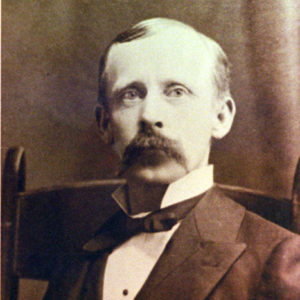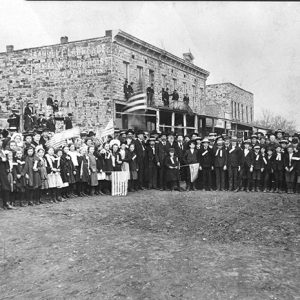calsfoundation@cals.org
John Sebastian Little (1851–1916)
Twenty-first Governor (1907)
John Sebastian Little was active in Arkansas Democratic Party politics for thirty years, holding the positions of prosecuting attorney, judge, congressman, and finally being elected governor in 1906. Persistent health problems ended his gubernatorial term very early, prompting accelerated efforts to provide the state with an elected lieutenant governor.
Born in Jenny Lind (Sebastian County), on March 15, 1851, Little was reputedly the first male child born in the newly created Sebastian County. Known was “Bass” Little, he was the son of Jesse and Elizabeth Tatum Little, pioneer settlers in western Arkansas. He grew up on the family’s farm and attended local schools.
In 1871–72, he spent a single term at Cane Hill College in Washington County. For the next three years, he taught school near his home while studying law under Judge C. B. Neal of Fort Smith (Sebastian County). Admitted to the bar in 1874, he briefly practiced law in nearby Greenwood (Sebastian County), before transferring his practice to Paris (Logan County) in about 1875. On January 4, 1877, he married Elizabeth Jane Irwin of Paris. The couple had five children.
Shortly after settling in Logan County, Little became active in Democratic Party politics. In 1876, he was elected prosecuting attorney of the Twelfth Judicial Circuit on the Democratic ticket and reelected for three additional two-year terms. In this position, he established himself as a highly effective courtroom performer and acquired a wide circle of friends and supporters. After returning to Greenwood, where he maintained his residence for the remainder of his life, he was elected in 1884 to represent Sebastian County in the lower house of Arkansas General Assembly and served in that capacity for one term during 1885. Elected judge of the Twelfth Judicial Circuit Court in 1886, he held that position until 1890. In 1890, he entered the fourth district congressional race against incumbent William L. Terry of Little Rock (Pulaski County) but withdrew from the race because of “nervous exhaustion.” The press implied that Little’s malady was as much emotional as physical. Apparently fully recovered by the summer of 1894, Little was elected to the United States House of Representatives, an office that he held until 1907.
Closely associated with William Jennings Bryan, a House colleague from Nebraska, Little was an ardent champion of “free silver,” prohibition, and antitrust legislation. Despite his concern for government economy, Little regularly sought and often secured expensive federal projects for his congressional district, including bridges and post offices.
Little decided to seek the Democratic nomination for governor of Arkansas in 1906, the same year that the incumbent governor, Jeff Davis, attempted to unseat James H. Berry, a veteran United States senator. Little’s chief rival for the gubernatorial nomination was Robert L. Rogers, the state’s independent-minded attorney general, who had alienated Governor Davis. Davis, therefore, threw his support to Little and verbally attacked Rogers. Little projected the image of a moderate who would restore harmony, decency, and unity to Arkansas’s Democratic Party. He avoided the blatantly racist tactics and anti-urban, anti-business biases that characterized Davis’s career. He attempted to withdraw from the governor’s race in 1906 presumably because of another episode of his “nervous” disorder, likely a severe form of melancholia, but was persuaded to persevere by his supporters. Victorious in the Democratic primary, Little won the general election, defeating his Republican opponent, John I. Worthington, by a vote of 105,586 to 46,262.
At his inauguration as governor on January 18, 1907, Little outlined a legislative program encompassing the proposals that he had discussed during the campaign. He called for free public school textbooks, the establishment of a textile school, greater support for the state university, abolition of the convict-leasing system, additional legislation to regulate corporations, the suppression of gambling, a comprehensive system of drainage and levees, improvements in roads, and an employers’ liability law.
Two days before his inauguration, reports of Little’s “indisposition,” followed by rumors of his death, circulated widely. The governor suffered a recurrence of melancholia within two days after his inauguration and, for a week or more, disappeared from view. Little returned home to Greenwood on the advice of his physicians, leaving his son, Paul Little, who served as his secretary, in charge of the governor’s office. Official documents were delivered to Greenwood for Little to sign.
Despite optimistic reports that Little would soon return to Little Rock to resume the duties of his office, he failed to do so. Failing to respond to treatment, the governor departed on February 11, 1907, for an extended period of recuperation to the Texas coast. On the date of the governor’s departure for the Gulf Coast, the president pro tempore of the state Senate, John Isaac Moore, became acting governor.
Since the existing state constitution did not make provision for a lieutenant governor, the established practice was for the president pro tempore of the state senate to become acting governor in the absence of the elected governor. When Little suffered a relapse and was unable to resume office by May 14, 1907, the date that the legislature adjourned, the newly elected president pro tempore of the state senate, Xenophon Overton Pindall, became acting governor and served for virtually all of the remainder of Little’s term. In 1908, Allen H. Hamiter, speaker of the Arkansas House of Representatives, had himself sworn in as acting governor when acting governor Pindall was out of state attending a conference. Hamiter served as acting governor for five days (May 9–14, 1908). Pindall resumed the office of acting governor upon his return to Little Rock and revoked Hamiter’s call for a special legislative session. When Pindall’s term as president pro tempore of the state Senate expired on January 11, 1909, his successor, Senator Jesse M. Martin, served as acting governor for three days until the inauguration of George W. Donaghey as governor. The musical chairs of acting governors following Little’s prolonged illness revived discussion of the need for an elected lieutenant governor. Such an office was approved by the voters of Arkansas in 1914 and confirmed by a decision of the state Supreme Court in 1926. In November 1926, Harvey Parnell became the state’s first elected lieutenant governor.
Little never regained his health or resumed the office of governor. He died on October 29, 1916, in Little Rock at the Arkansas State Hospital for Nervous Diseases and was buried in City Cemetery in Greenwood.
For additional information:
Biographical Directory of the American Congress, 1774–1971. Washington DC: Government Printing Office, 1971.
Donovan, Timothy P., Willard B. Gatewood Jr., and Jeannie M. Whayne, eds. The Governors of Arkansas: Essays in Political Biography. 2d ed. Fayetteville: University of Arkansas Press, 1995.
Little, Freed S. John Sebastian Little, 1851-1916: The Great Commoner. N.p.: 1994.
Willard B. Gatewood
University of Arkansas, Fayetteville
This entry, originally published in Arkansas Biography: A Collection of Notable Lives, appears in the CALS Encyclopedia of Arkansas in an altered form. Arkansas Biography is available from the University of Arkansas Press.
 Early Twentieth Century, 1901 through 1940
Early Twentieth Century, 1901 through 1940 Politics and Government
Politics and Government John Little
John Little  John Little
John Little  John Sebastian Little Monument
John Sebastian Little Monument  Governor John Little Reception
Governor John Little Reception 




John Sebastian Little was very good family friends with my great-great-granddad. Such good friends that my dad’s dad was named after John Little.
Then when I was born, my dad named me again after John Little, and this is how I got my middle name LITTLE. Cool huh? Anyway, I think so.